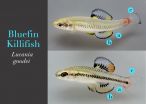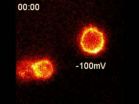Penn researchers untangle the biological effects of blue light
A tug-of-war is revealed in the response of the eye to blue light, with implications for the study of light sensitivity and seasonal depression
2014-10-21
(Press-News.org) PHILADELPHIA – Blue light can both set the mood and set in motion important biological responses. Researchers at the University of Pennsylvania's School of Medicine and School of Arts and Sciences have teased apart the separate biological responses of the human eye to blue light, revealing an unexpected contest for control. Their work addresses the properties of melanopsin, a light-sensitive protein in the eye that establishes the rhythm of our day-night cycle and the familiar constriction of the pupil to bright light. They measured the pupil response to stimulation of melanopsin and of short-wave-sensitive (S) cones, the other blue light-sensing cells that operate in daylight. Surprisingly, they found that melanopsin and S-cones have opposite effects and compete for control of the pupil in blue light. Their complete results are published in the current issue of PNAS.
"The challenge of studying melanopsin is that it is very sensitive to blue light, a short-wave light emitted by digital devices including smartphones, tablets, and computers, as are S-cones," says lead author, Manuel Spitschan, a Penn graduate student in psychology. "Previous studies in the human eye have not separately studied the S-cones and melanopsin because flashing a blue light stimulates both of these cells, so we didn't know if what a person saw or the response of the pupil was from one or both." To overcome this problem, the Penn team developed a special class of visual stimuli: they produced flickering light that stimulates melanopsin but is invisible to S-cones, and a second flickering light that stimulates S-cones but is invisible to melanopsin. The lights were created using a machine that can sculpt and switch between computer-designed rainbows of light.
The researchers had 16 people watch this flickering light while the response of their pupil was recorded. The light that stimulates melanopsin made the pupil slowly contract. To their surprise, they also discovered that stimulation of S-cones made the pupil get larger. That is, when the S-cones of the eye captured more light, the pupil enlarged, the opposite of what is generally thought of as the natural pupil response. This means that blue light sets off a tug-of-war between melanopsin and S-cones to make your pupil smaller or bigger. The melanopsin effect is stronger, resulting in the familiar shrinking of the pupil to bright light of any color.
"For the first time in people we are able to probe the relationship between melanopsin signals and the cones and how they work together or in opposition," says David Brainard, PhD, RRL professor of Psychology, director of the Vision Research Center and director of the Institute for Research in Cognitive Science. And what do these special flickering lights look like? "The flicker that stimulates S-cones looks like it is switching between a bluish and yellowish color. The flicker that stimulates melanopsin, however, is hard to see, and looks like a soft glow that rises and falls in brightness."
Light enters the human eye and is imaged on the retina. It has long been know that the retinal image is sensed by neurons known as the rods and cones. The rods operate in dim light levels and allow us to see at night. It is the signals from rods and cones that the brain converts into the images we see.
Recently, though, another class of retinal cells has been identified that also senses light. These cells are known as intrinsically photosensitive ganglion cells, and they contain the protein melanopsin. Melanopsin is sensitive to light at wavelengths intermediate to those sensed by the S and M cones. It appears that it primarily mediates light-driven functions other than conscious vision, such as setting our circadian clock and contributing to control of the pupil.
The work of the Penn team makes it possible to isolate and study the properties of melanopsin in people, separate from the cone cells. We can now ask what we "see" with melanopsin.
"This is important because we think melanopsin could be involved in clinical conditions," says Geoffrey K. Aguirre, MD, PhD, a behavioral neurologist and associate professor in the department of Neurology. "For example, it seems that too much stimulation of melanopsin produces the feeling of pain from light that is too bright, and not having enough melanopsin stimulation may be part of seasonal affective disorder, in which people become depressed when they don't have enough light exposure. Having now teased apart the melanopsin and cone responses to blue light, we can study how the eye is involved in these disorders."
A patent on this alternative photoreceptor isolation method and its applications has been filed by the University of Pennsylvania with Spitschan, Aguirre and Brainard as inventors. In addition, they have founded a company with the Penn UpStart incubator with the goal to commercialize a device based upon these techniques.
INFORMATION:
This work was supported by NIH grants R01 EY020516, R01 EY10016 and P30 EY001583.
Penn Medicine is one of the world's leading academic medical centers, dedicated to the related missions of medical education, biomedical research, and excellence in patient care. Penn Medicine consists of the Raymond and Ruth Perelman School of Medicine at the University of Pennsylvania (founded in 1765 as the nation's first medical school) and the University of Pennsylvania Health System, which together form a $4.3 billion enterprise.
The Perelman School of Medicine has been ranked among the top five medical schools in the United States for the past 17 years, according to U.S. News & World Report's survey of research-oriented medical schools. The School is consistently among the nation's top recipients of funding from the National Institutes of Health, with $392 million awarded in the 2013 fiscal year.
The University of Pennsylvania Health System's patient care facilities include: The Hospital of the University of Pennsylvania -- recognized as one of the nation's top "Honor Roll" hospitals by U.S. News & World Report; Penn Presbyterian Medical Center; Chester County Hospital; Penn Wissahickon Hospice; and Pennsylvania Hospital -- the nation's first hospital, founded in 1751. Additional affiliated inpatient care facilities and services throughout the Philadelphia region include Chestnut Hill Hospital and Good Shepherd Penn Partners, a partnership between Good Shepherd Rehabilitation Network and Penn Medicine.
Penn Medicine is committed to improving lives and health through a variety of community-based programs and activities. In fiscal year 2013, Penn Medicine provided $814 million to benefit our community.
[Attachments] See images for this press release:

ELSE PRESS RELEASES FROM THIS DATE:
2014-10-21
WASHINGTON, DC – October 20, 2014 -- Lactobacillus species, commonly seen in yogurt cultures, correlate, in the guts of mouse models, with mitigation of lupus symptoms, while Lachnospiraceae, a type of Clostridia, correlate with worsening, according to research published ahead of print in Applied and Environmental Microbiology. "Our results suggest that the same investigation shold be performed in human subjects with lupus," says principal investigator Xin Luo of Virginia Tech, Blacksburg, VA.
In the study, the investigators first showed that mouse models of lupus ...
2014-10-21
Tropical Storm Gonzalo strengthened into a hurricane on Oct. 14 when it was near Puerto Rico and provided a natural laboratory for the next phase of NASA's HS3 or Hurricane and Severe Storm Sentinel mission.
The WB-57 aircraft flew over Hurricane Gonzalo on Oct. 15 carrying two HS3 mission instruments called HIWRAP and HIRAD in addition to a new Office of Naval Research sponsored dropsonde system.
The WB-57 is a mid-wing, long-range aircraft capable of operation for extended periods of time from sea level to altitudes in excess of 60,000 feet. Two crew members are positioned ...
2014-10-20
For treating patients with prescription opioid dependence in primary care, buprenorphine maintenance therapy is superior to detoxification, according to a new study by Yale School of Medicine researchers published in the Oct. 20 issue of JAMA Internal Medicine.
Prescription opioid dependence has been increasing for the last 15 years and now surpasses heroin dependence. Doctors are also writing more prescriptions for pain management, which has led to higher experimentation and addiction rates, according to lead author David Fiellin, M.D., professor of internal medicine ...
2014-10-20
Scientists have developed new geochemical tracers that can identify hydraulic fracturing flowback fluids that have been spilled or released into the environment.
The tracers have been field-tested at a spill site in West Virginia and downstream from an oil and gas brine wastewater treatment plant in Pennsylvania.
"By characterizing the isotopic and geochemical fingerprints of enriched boron and lithium in flowback water from hydraulic fracturing, we can now track the presence of 'frac' fluids in the environment and distinguish them from wastewater coming from other ...
2014-10-20
LIVERMORE, Calif. – New medications created by pharmaceutical companies have helped millions of Americans alleviate pain and suffering from their medical conditions. However, the drug creation process often misses many side effects that kill at least 100,000 patients a year, according to the journal Nature.
Lawrence Livermore National Laboratory researchers have discovered a high-tech method of using supercomputers to identify proteins that cause medications to have certain adverse drug reactions (ADR) or side effects. They are using high-performance computers ...
2014-10-20
Preexisting differences in the sensitivity of a key part of each individual's immune system to stress confer a greater risk of developing stress-related depression or anxiety, according to a study conducted at the Icahn School of Medicine at Mount Sinai and published October 20 in the Proceedings of the National Academy of Sciences (PNAS).
Inflammation is the immune system's response to infection or disease, and has long been linked to stress. Previous studies have found depression and anxiety to be associated with elevated blood levels of inflammatory molecules ...
2014-10-20
CHAMPAIGN, Ill. — They help fish swim, but fins also advertise a fish's social standing and health. In a new study, researchers report that for the male bluefin killifish (Lucania goodei), each colorful fin presents its own messages to other fish.
Researchers report their findings in the journal Behavioral Ecology.
They're called "bluefin" killifish, but the first thing University of Illinois animal biology professor Rebecca Fuller noticed while she was snorkeling in a Florida stream was the killifishes' differently colored fins. In addition to having reflective ...
2014-10-20
Fairfax, Va., October 20, 2014—Tumor laterality (left-side vs. right-side) does not impact overall survival in breast cancer patients treated with breast-conserving surgery and adjuvant external beam radiation therapy, according to a study published in the October 1, 2014 issue of the International Journal of Radiation Oncology • Biology • Physics (Red Journal), the official scientific journal of the American Society for Radiation Oncology (ASTRO).
Studies have shown that breast cancer patients treated with radiation therapy have improved local-regional recurrence, ...
2014-10-20
VIDEO:
The movie is quantitative imaging of cells with potassium channels, bathed in dilute fluorescent tarantula toxin. Pixel color indicates intensity of tarantula toxin concentration. The circular shapes are cell surfaces,...
Click here for more information.
WOODS HOLE, Mass.--A novel probe that reports on the electrical activity of cells, made by fusing tarantula toxin with a fluorescent compound, is described in a paper today by scientists from the University of California, ...
2014-10-20
PULLMAN, Wash.—Researchers led by a Washington State University biologist have found the optimal mechanism by which plants heal the botanical equivalent of a bad sunburn. Their work, published in the Proceedings of the National Academy of Sciences, could lead to the development of crops that can repair the sun's damage more easily, improving yields and profitability.
Helmut Kirchhoff, an assistant professor in WSU's Institute of Biological Chemistry and corresponding author of the PNAS paper, said plants have had to deal with solar damage since the evolution of photosynthesis ...
LAST 30 PRESS RELEASES:
[Press-News.org] Penn researchers untangle the biological effects of blue light
A tug-of-war is revealed in the response of the eye to blue light, with implications for the study of light sensitivity and seasonal depression




